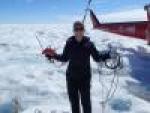event
Influence of Meltwater on Greenland Ice Sheet Dynamics
Primary tabs
The School of Earth and Atmospheric Sciences Presents Dr. Laura Stevens, Columbia University
Mass loss from the Greenland Ice Sheet contributes a quarter of today’s global sea level rise. Roughly half of this Greenland Ice Sheet mass loss is derived from accelerated flow of the ice sheet due in part to the ability of surface meltwater to access, lubricate, and enhance sliding along the ice-bed interface.
Determining the processes that govern the ice sheet’s dynamic flow response to increased surface meltwater production is critical for understanding how ice sheets work and predicting how ice sheets will behave in our warming climate.
This talk will examine the influence of meltwater on two regimes of Greenland Ice Sheet flow: (1) rapid supraglacial lake drainages in the slowly-flowing inland margin, and (2) diurnal meltwater influences on fast-flowing marine-terminating outlet glaciers.
A combination of Global Positioning System (GPS) observations of ice-sheet surface displacement, inverse methods, and time series analysis will be used to investigate these processes.
In the slow-flowing regime, rapid supraglacial lake drainages provide an ideal natural experiment that enables us to probe the upper limits of meltwater’s influence on ice-flow acceleration. These lake drainages are spectacular events, where hydro-fractures—water-driven crevasses—drain ~3-km diameter lakes from the surface to the bed of the ice sheet in a matter of hours at rates equivalent to the discharge across Niagara Falls.
This half of the talk will investigate what triggers rapid lake drainage using a Network Inversion Filter (NIF) to invert a dense, local network of GPS observations during three lake drainage events.
In the fast-flowing regime, marine-terminating outlet glaciers are the gatekeepers of the inland ice sheet’s access to the sea. The dynamics of these glaciers are governed by complex interactions between the atmosphere, ocean, and ice-sheet bed.
This half of the talk will investigate how atmospheric and oceanic forcing influence short-term (hourly) variations in horizontal flow of Helheim Glacier, East Greenland as observed by an array of GPS receivers. Improved mechanistic understanding of how tidal and atmospheric forcing drive marine outlet glacier flow is critical for determining how rapidly ice will be discharged into the ocean as these regions warm.
Status
- Workflow Status:Published
- Created By:nlawson3
- Created:12/13/2018
- Modified By:nlawson3
- Modified:01/09/2019
Categories
Keywords
Target Audience

